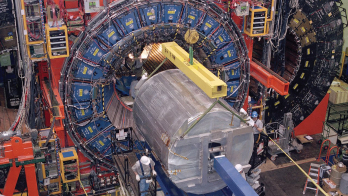
A new theoretical calculation of the effects of the nuclear medium may account for the “NuTeV anomaly”, a puzzling experimental result that disagreed with the Standard Model. The solution may lie with the isovector nuclear force generated by excess neutrons or protons in iron, which produces a subtle change in the quark structure of all of the nucleons.
The NuTeV anomaly arose when the Neutrinos at the Tevatron (NuTeV) collaboration at Fermilab measured the ratio of neutral-current to charged-current reactions in the collisions of high-energy neutrinos (and antineutrinos) with a large steel target (Zeller et al. 2002). The measurements gave a value for the electroweak parameter sin2θW that was three standard deviations higher than predicted by the Standard Model. When analysing the data, however, the collaboration had to make a correction to compensate for the unequal numbers of protons and neutrons in the iron nuclei in the steel target. In the analysis, the effect of the extra neutrons was removed by subtracting the structure functions of a comparable number of free neutrons from the iron nucleus, assuming that the protons and neutrons bound inside the iron nucleus are identical to free protons and neutrons.
Changes in structure functions in bound nucleons are well known through the effect discovered by the European Muon Collaboration (EMC). Now theorists from Tokai University, the University of Washington and Jefferson Lab have revealed a novel isovector EMC effect, arising from a proton or neutron excess. This effect implies an additional correction, of a sign and magnitude that are essentially model independent, which removes at least half of the NuTeV anomaly (Cloët et al. 2009). Moreover, when the new effect is combined with the well known correction for charge symmetry violation in the nucleon itself, the NuTeV data turn out to be in excellent agreement with the Standard Model.
The NuTeV data may be seen as providing crucial evidence for a conceptual change in the understanding of nuclear structure, in which the quark structure of the bound nucleon is fundamentally modified by the medium. Independent experimental confirmation of the isovector EMC effect could be provided by charged-current studies on heavy nuclei at a future electron-ion collider and in parity-violating deep-inelastic scattering experiments at Jefferson Lab following the 12 GeV upgrade.
Further reading
G P Zeller et al. [NuTeV Collaboration] 2002 Phys. Rev. Lett. 88 091802;
G P Zeller et al. [NuTeV Collaboration] 2003 Phys. Rev. Lett 90 239902.
I C Cloët, W Bentz and A W Thomas 2009 Phys. Rev. Lett. 102 252301.





